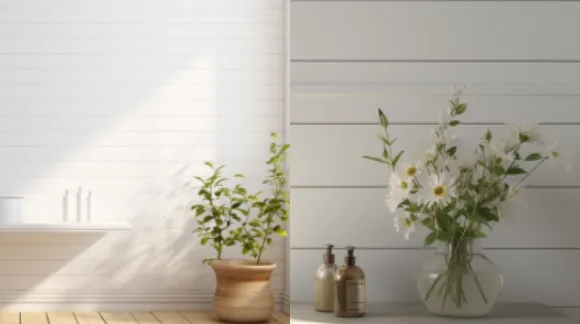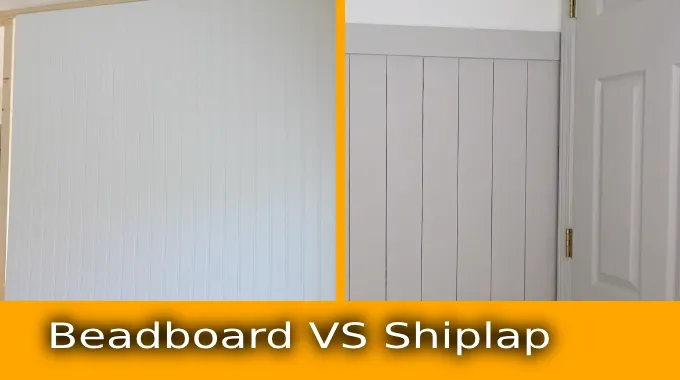Last Updated on September 16, 2023
Beadboard and shiplap are two distinct interior design elements that transform your living space’s ambiance. As you embark on designing a space that resonates with your style and vision, understanding the differences between Beadboard and Shiplap products is essential.
Beadboard is made from various materials, including wood, MDF, and PVC, and showcases vertical grooves known as “beads.” These panels evoke a classic and timeless aesthetic, often used to add elegance to walls and ceilings.
Conversely, Shiplap boasts a rustic charm with its horizontally stacked wooden planks, creating distinct lines that exude warmth and texture.
In terms of cost, beadboard stands as the more budget-friendly option, whereas shiplap prices vary based on material and style choices. But the differences between Beadboard and Shiplap don’t end there.
We’ll examine the intricate details that distinguish beadboard from shiplap. From that, you can choose the best wall material for your home.
Beadboard vs Shiplap: Differences in 7 Categories

When considering the distinctions between beadboard and shiplap, there are several differences you need to know.
1. Material composition
2. Size and spacing
3. Aesthetic styles and design flexibility
5. Suitability for environments
5. Ease of installation
6. Maintenance and painting
7. Cost considerations
Let’s examine the distinctions between beadboard and shiplap in each category.
1. Material Composition
Regarding material composition, Beadboard is a type of wooden paneling made from various materials such as wood, MDF (Medium-Density Fiberboard), or PVC. The characteristic feature of beadboard is the vertical grooves called “beads,” running along the length of the panel.
In contrast, shiplap is primarily crafted from pine or cedar due to the material’s natural strength and durability. These materials lend themselves well to creating the overlapping horizontal planks characteristic of shiplap walls.
2. Size and Spacing
As for size and spacing, Beadboard panels are typically sold in sheets measuring 4′ x 8′. The individual narrow wooden planks are installed vertically, with distinctive grooves (beads) between each plank. The bead spacing creates a uniform and textured look.
On the other hand, shiplap is available in different widths like 5 ½-inch and 7 ¼-inch options. The narrower width can create a more subtle and refined look, perfect for smaller rooms or areas where you want a delicate touch.
3. Aesthetic Styles and Design Flexibility
Comparing aesthetic styles and design flexibility, Beadboard lends itself to a classic and traditional aesthetic. This material often creates Decorative accents on walls, ceilings, and wainscoting. It adds elegance, sophistication, and texture to spaces and is suitable for creating a timeless look.
Conversely, shiplap creates a rustic and farmhouse-style appearance with its distinct horizontal lines that evoke warmth and texture. It is a popular choice for achieving a cozy and inviting atmosphere. Though white is commonly chosen, Shiplap can also be painted in various colors.
5. Suitability for Environments
When considering where to use beadboard or shiplap, you need to consider the environment in which they will be installed.
Beadboard is not recommended for high-moisture areas like bathrooms and kitchens because it can warp or rot when exposed to excess humidity. It is best suited for dry spaces such as living rooms, dining rooms, and bedrooms, with minimal moisture exposure.
In contrast, shiplap is more resilient and weather-resistant for exterior applications than beadboard, but it should still be avoided in moisture-prone indoor areas.
Even though shiplap is less susceptible to warping or rotting than beadboard, it can still be affected by moisture over time.
5. Ease of Installation
Shiplap tends to be easier to install than beadboard due to its self-spacing nature and interlocking joints.
With shiplap, the boards simply stack on each other, creating a tight seal without additional spacing or caulking.
Meanwhile, beadboard requires more attention to detail during installation. It needs to be carefully aligned and spaced properly using spacers or nails for an even look.
Also, power tools like a jigsaw or circular saw may be needed to trim sections of shiplap and beadboard if necessary.
6. Maintenance and Painting
The flat surface of the Beadboard makes it easier to wipe down than shiplap for maintenance and painting. But, it may be more susceptible to dings and scuffs. Painting beadboard can be more manageable than shiplap, as there are no grooves to navigate.
Conversely, the grooves in shiplap can collect dust over time and may require regular cleaning. Painting shiplap can be more challenging because the grooves require careful application to avoid paint buildup.
7. Cost Considerations
The cost of beadboard is generally less than that of shiplap regarding cost considerations. A 4’x8′ panel of beadboard costs approximately $0.72 per square foot. This makes beadboard a budget-friendly option for those looking for decorative wall paneling.
Meanwhile, Shiplap prices vary, usually ranging from approximately $2.50 to $7.00 per square foot for real wooden boards.
While shiplap-like wallpaper or MDF boards can be cheaper alternatives, genuine wood shiplap tends to be more expensive than beadboard.
Beadboard or Shiplap: Which Option Should You Select?

Choosing between beadboard and shiplap depends on your design preferences, intended space, and budget.
Beadboard is an excellent choice if you seek a timeless and elegant aesthetic. Generally, it is ideal for living rooms, dining rooms, and bedrooms with minimal moisture exposure. Its flat surface makes it easy to clean and paint so that it can be used for a wide variety of design ideas.
Shiplap is the way to go if a cozy, rustic, inviting ambiance aligns with your vision. Its horizontal lines bring warmth to spaces, and it’s often selected for its farmhouse-style appeal. While shiplap’s grooves might require extra cleaning effort, its weatherproof nature and durability make it suitable for exterior applications.
Regarding cost, beadboard offers a more budget-friendly solution, perfect for those looking to enhance their interiors without breaking the bank. Shiplap, although pricier, can justify the cost with its enduring and versatile characteristics.
Overall, the decision rests on your desired style, maintenance preferences, and the specific demands of the space you’re working with.
Can you put a shiplap on a curved wall?
You can install a shiplap on a curved wall, but it requires careful planning and proper technique. The shiplap’s linear design and overlapping structure make accommodating curves more challenging than straight surfaces.
To achieve this, you should make precise cuts on the shiplap boards to match the curve of the wall. Flexible materials like vinyl or PVC trim can simplify the installation process on curved surfaces.
Also, selecting appropriate trim options, such as a quarter round for corners, can help cap off the ends of the shiplap and create a polished finish.
Keep in mind that working with curved surfaces may require advanced woodworking skills or the assistance of a professional installer to achieve the desired result.
Enhance Your Design Aesthetic with Beadboard and Shiplap
You now understand the differences between beadboard and shiplap, from their material composition to suitability for different environments.
Each option brings its own unique charm to interior design, whether it’s beadboard’s timeless elegance or shiplap’s rustic warmth.
Consider your design preferences, maintenance expectations, and budget as you make your choice. Beadboard offers a budget-friendly solution with versatility, while shiplap boasts enduring appeal and a cozy atmosphere.
Ultimately, the decision rests on your vision and the demands of your space. Take advantage of these design elements to create a space that reflects your personal taste and style.



